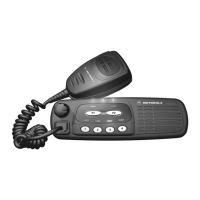Section 10: 2-4 UHF Band 2 (450–512/520 MHz) 25–40 W Bipolar Transmitter Power Amplifier (PA) 40W
6881091C63-F
In receive mode, the voltage control line is at ground level and turns off Q5473, which in turn
switches off the biasing voltage to U5401.
3.2 Pre-Driver Stage
The next stage is a 13dB gain LDMOS device (Q5421) which requires a positive gate bias and a
quiescent current flow for proper operation. The voltage of the line PCIC_MOSBIAS_1 is set in
transmit mode by PCIC, pin 24 and fed to the gate of Q5421 via the resistive network R5407,
R5408, R5416, and R5415. The bias voltage is factory tuned.
3.3 Driver Stage
This stage is an enhancement-mode N-Channel MOSFET device (Q5431) providing a gain of 10dB.
This device also requires a positive gate bias and a quiescent current flow for proper operation. The
voltage of the line Bias_2_UHF_PA_1 is set in transmit mode by the ASFIC and fed to the gate of
Q5431 via resistive network R5630, R5631, and R5632. This bias voltage is also factory tuned.
If the transistor is replaced, the bias voltage must be tuned using the Customer Programming
Software (CPS). Care must be taken not to damage the device by exceeding the maximum allowed
bias voltage. The device’s drain current is drawn directly from the radio’s DC supply voltage input,
A+ via L5421.
3.4 Final Stage
The final stage uses bipolar device Q5441 whose collector current is also drawn from the radio’s DC
supply voltage input. To maintain class C operation, the base is DC-grounded by series inductor
L5441 and bead L5440. A matching network consisting of C5541 – C5544 and two striplines
transform the impedance to 50 ohms and also feed the directional coupler.
3.5 Bi-directional Coupler
The bi-directional coupler is a microstrip printed circuit, which couples a small amount of the forward
and reverse power of the RF power from Q5441. The coupled signal is rectified to an output power
proportional DC voltage by diodes D5451 and D5452 before being sent to the RFIN input of the
PCIC. The PCIC controls the gain of stage U5401 as necessary to hold this voltage constant. This
ensures the forward power out of the radio is held to a constant value.
3.6 Antenna Switch
The antenna switch utilizes the existing DC feed (A+) to the last stage device (Q5441). Basic
operation is to have both PIN diodes (D5471 and D5472) turned on during key-up by forward
biasing them. This is achieved by pulling down the voltage at the cathode end of D5472 to around
11.8V (0.7V drop across each diode). The current through the diodes needs to be set around 80mA
to fully open the transmit path through resistor R5496. Q5472 is a current source controlled by
Q5471 and is eventually connected to pin ANO of PCIC. VR5471 ensures the voltage at resistor
R4511 never exceeds 5.6V.

